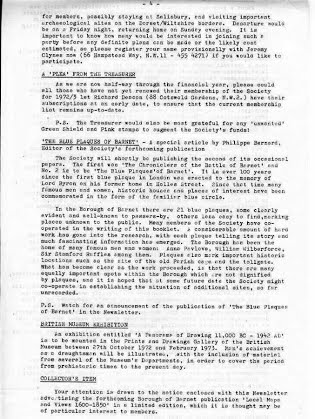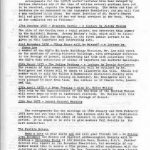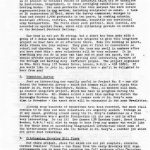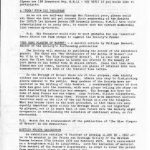
Page 1
Looking back at Summer Pursuits
Winchester outing. Despite heavy rain during the evening and night preceding the final outing of the season of that September, a party of 37 assembled for the expedition to Winchester. They were rewarded, for the clouds began to clear at the outset and the weather remained reasonable all day. The first stop was at Sparsholt Roman Villa, situated in the middle of a forestry plantation just outside Winchester. The approach was appropriately via a of Roman Road and we were conducted around the side by Mr David Johnston of the Extra-Mural Department of Southampton University. Evidence existed of occupation from the Iron Age to the mid-4th century A.D. At the most important phase there was a big house with a large courtyard, an aisled building and various out-buildings. There was also an interesting a sequence in the development of the Bath House and a beautiful mosaic floor has been uncovered, which we later saw in the City Museum at Winchester. Some more wall plaster, imitating mosaic was another interesting a find.
From of the villa we returned to Winchester, where we were free to explore until 2.30 p.m., when we met at the City Museum to see some of the evidence of Winchester’s long and eventful history. Mr. Cottrill, the curator, was kind enough to be available to answer questions. Next we proceeded to the cathedral to meet Canon Bussby, who introduced us to its history. We saw an exhibition of Saxon and Norman art in the Treasury, and the beautiful twelfth century Winchester Bible, kept in the library, itself the oldest bookroom in Europe, also dating from the twelfth century. The Canon told us something of the cathedrals administration, including the fact that when the gates of the Close are shut at night, the community has nothing further to do with England until the next morning. We finally repaired at to the Cadens Cafe in the High Street for tea before returning home.
Brent River Walk
The upper reaches of the year River Brent (or Dollis Brook) were explored on the sunny afternoon or Saturday 23 September by a regrettably small party, half of which was comprised of members of the Middlesex Society, under the leadership Mr Jeffrey Evans. Shortly after the start at Totteridge Lane, the Middlesex Hertfordshire boundary was located near the road named County Gate. From here the walkers followed the diminishing river westward to a point beyond Totteridge Vale Farm.
Nothing of note was found in the river gravels. Some pollution from tipped rubbish was noted at one point near a car park and it was thought that a complaint would be justified. On the return journey, the travellers were welcomed by the Trewicks in Western Way and refreshed to buy a delicious tea – a bonus highlight to a pleasant occasion. As mentioned in the previous newsletter, it is hoped that there will be a further walk to find the river’s source next spring.
Second Chance
Those members who missed the first of Mr Jeffrey Evans’ river walks by along the lower reaches of the River Brent, may be interested to know that he will be conducting a similar walk for the Middlesex Society on the Saturday 4 November meeting at the Brent Bridge, Hendon, NW4 at 2.30 p.m.
Page 2
Erratum
The Editor wishes to apologise to all bemused Anglo-Saxon scholars and to Mr Jeffrey Evans for incorrectly rendering “GRENDELES GATAN” as “Grendchen Gatan” when the transcribing the original handwritten draft of his feature article along by Brent which appeared in the September newsletter.
Looking Ahead to Winter Plans
Lectures
Arrangements for the 1972/3 Winter lectures have been delayed by various obstacles and at the time of writing several problems have yet to be resolved, reports the Programme Secretary. The date and time of lectures are as announced in the September newsletter, and you will find a map enclosed which shows the exact location of St. Mary’s Church Hall and gives details of bus and services in the area. Plans so far completed are as follows: –
17th October 1972 – Baynards Castle – a Lecture by Jeremy Haslam
The site of the castle, once a Royal Palace, was excavated this summer by the Guildhall Museum. Jeremy Haslam’s talk, which will be illustrated with slides and diagrams, is the first public lecture to be given on this important and interesting site.
21st November 1972 – “They’ll never be missed” – a lecture by James Lee
A member of the GLC’s Historic Buildings Division, Mr Lee will speak on the problems of saving historic buildings, with particular reference to the Borough of Barnet, illustrating his talk with selections from the GLC’s fine collection of slides of important and historic buildings.
20th March 1973 – The Fulham Pottery – a lecture by Dennis Haselgrove
The result of this summer’s excavations will be outlined by Mr Haselgrove and slides will be shown to illustrate his talk. Should any member wish to help the Fulham and Hammersmith Historical Society with the processing of finds (mainly on Sundays), Mr Haselgrove will be very pleased to hear from them.
17th April 1973 – A Maps Evening – with Dr, Helen Wallis
This talk by the Superintendent of the Map Room of the British Museum will cover maps as aides to historical research. Dr Wallis will talk with special local reference to the Borough of Barnet.
15h May 1973 – Annual General Meeting
Other Meetings
The arrangements for the meetings on 16th January and 20 February 1973 have not yet been finalised. One lecture will be on a prehistoric subject, however, and the other of interest to students of the Roman period. It is hoped to be able to give members full details in the next newsletter.
The Festive Season
Make a note in your diary now and tell your friends to – on Friday 15th December the Hendon and District Archaeological Society will be holding a Christmas Party at 166 Station Road, Hendon, NW4. Further details will appear in the November newsletter, but meanwhile if any member would like to donate raffle prizes, or offer assistance with the catering or other arrangements, the Treasurer (Richard Deacon) would be very pleased to hear from you.
Sadly the last social gathering was poorly attended, despite great efforts on the part of those who undertook the organisation, so make a firm resolution now to come along and enjoy yourselves on 15 December.
Projects
The Society has several research projects planned for the coming winter :-
Page 3
Portrait Survey
About a year ago, Hendon and District Archaeological Society was invited by the London and Middlesex Archaeological Society to participate in the Middlesex Portrait Survey with responsibility for the Borough of Barnet. From the outset, the idea appealed to the Committee as being both worthwhile and of interest to members. For various reasons, however, the start had to be postponed until now.
The idea behind the survey (which is part of a nationwide Portrait Survey, organised on a County basis) is to fill the gap which exists when a portrait can not be found in one of the larger galleries. There is at present no national record of portraits which can be consulted by historians, biographers, or those arranging exhibitions or illustrating books. Yet such portraits (for this purpose, the word covers representations in any medium, including sculpture) do exist. A team of 30 researchers in Kent, where the survey commenced, managed to find and record 1,400 portraits in two years, by combing schools, municipal offices, vestries, boardrooms, hospitals and territorial army headquarters. The facts about each portrait, when located, are recorded on a special form, which will ultimately provide an archive at the National Portrait Gallery.
Our team is not yet 30 string, but a start has been made with a group of a dozen keen members who are prepared to give this long-term project an hour here or an afternoon there. Some are working in pairs, while others are lone wolves. They plan at first to concentrate on schools and churches. We hop that the team may swell in numbers after you have read this – more volunteers will be very welcome! It is something you can do in your own time and at your own speed, and it should provide opportunities for getting into interesting corners of the Borough and meeting many different people. The project organiser is Mrs. Nell Penny. If you would like to join in, please contact her – she’ll be delighted to hear from you.
Tombstone Survey
Just as interesting and equally useful is Project No. 2 – our old friend the Tombstone Survey – which Ted Sammes will direct again this winter in St, Mary’s Churchyard, Hendon. This, as members will know, is another long-term project, which has been in progress during the last two winters. Mr. Sammes called a halt this spring to direct the Burroughs Gardens dig, but hopes top resume work at St. Mary’s some time in November – the exact date will be announced in the next Newsletter.
Already many hundreds of headstones have been recorded, but much still remains to be done and more volunteers are needed. Strange as it may sound, grubbing around among the St, Mary’s tombstones on a fine Sunday afternoon has a gentle fascination all its own – and is often very interesting. Do try it! Mr. Sammes will also be happy to hear from any member who would like to try their hand at assembling biographical information about some of the better-known worthies who are buried at St. Mary’s – another job which can prove most rewarding.
Cataloguing Brockley Hill finds
Our third project, plans for which are not yet complete, concerns another familiar friend – the finds from the early Brockley Hill digs. Arrangements are in had for spending two full weekends after Christmas on further sorting, cataloguing and indexing at the Hampstead Garden Suburb Institute. This will provide an excellent chance to handle, identify and get used to the feel of Roman pottery from the late 1st to the early 4th century. Further details will appear in subse1quent newsletters.
Page 4
Looking forward to next Spring – Archaeological Weekend
It has been proposed that the Society should organise a weekend trip for members, possibly staying at Salisbury, and visiting important archaeological sites on the Dorset/Wiltshire borders. Departure would be on a Friday night, returning home on Sunday evening. It is important to know how many would be interested in joining such a party before any definite plans are made or the likely cost estimated, so please register your name provisionally with Jeremy Clynes now if you would like to participate.
Subscriptions
As we are now half way through the financial year, please could all those who have not yet renewed their membership of the Society for 1972/3 let Richard Deacon have their subscriptions at an early date, to ensure that the current membership list remains up-to-date.
P,S, The Treasure would also be most grateful for any unwanted Green Shield or Pink stamps to augment the Society’s funds.
The Blue Plaques of Barnet
– A special article by Philippa Bernard, Editor of the Society’s forthcoming publication.
The Society will shortly be publishing the second of its occasional papers. The first was “The Chroniclers of the Battle of Barnet” and No. 2. is to be “The Blue Plaques of Barnet”. It is over 100 years since the first blue plaque in London was erected to the memory of Lord Byron on his former home in Holles Street. Since that time, many famous men and women, historic houses and place of interest have been commemorated in the form of the familiar blue circle.
In the Borough of Barnet, there are 21 Blue Plaques, some clearly evident and well-known to passers-by, others less easy to find, marking places unknown to the public. Many members of the Society have co-operated in the writing of this booklet. A considerable amount of hard work has gone into the research, with each plaque telling its story and much fascinating information has emerged. The Borough has been the home of many famous men and women: Anna Pavlova, Wllliam Wilberforce, Sir Stamford Raffles among them. Plaques also mark important historical locations such as the site of the old parish cage and the tollgate. What has become clear as work proceeded, is that there are many equally important spots within the Borough which are not dignified by plaques, and it is hoped that at some future date the Society might co-operate in establishing the situation of additional sites, so far unrecorded.
P.S. Watch for an announcement of the publication of “The Blue Plaques of Barnet” in the Newsletter.
British Museum Exhibition
An exhibition entitled “A Panorama of Drawing, 11,000 B.C. – 1942 A.D.” is to be mounted in the Prints and Drawings Gallery of the British Museum between 27th October 1972 and February 1973. Man’s achievement as a draughtsman will be illustrated, with the inclusion of material from several of the Museum’s Departments, in order to cover the period from prehistoric times to the present day.
Collector’s Item
Your attention is drawn to the notice enclosed with this newsletter advertising the forthcoming Borough of Barnet publication “Local Maps and Views 1600-1850” in a limited edition, which it is thought may be of particular interest to members.




